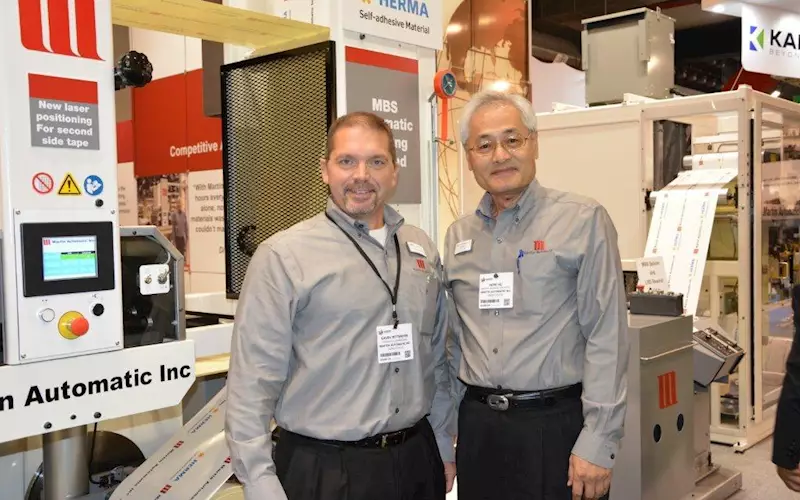In a conversation with Noel D’Cunha, Martin Automatic’s vice president, sales & marketing, Gavin Rittmeyer says that there are many benefits to non-stop roll change, including time and resources
PrintWeek India (PWI): What is your star product at the Labelexpo Europe 2015?
Gavin Rittmeyer (GR): Right now at the stand, Martin Automatic is running demonstrations of the MBS splicer and the LRD rewinder.
PWI: Can you explain what’s new and how will it benefit the customers?
GR: The MBS splicer now comes with a new capability to run substates from PS label stock to flexible and is fitted with a touch screen control.
Of special interest to visitors, the MBS splicer on exhibition features an alternate stacked festoon (accumulator) design. This design enables Martin to fit the splicer into a short footprint required by the end-user.
The LRD is a two-spindle transfer rewind that winds and changes rolls, and then unloads them, all automatically, without any need for additional roll handling equipment like roll carts.
PWI: In terms of functionality, has the role of labels enhanced or it still is a piece of decoration?
GR: Labels are decorative, to be sure, but they serve many other purposes—information, security, packaging, asset protection, etc. In a similar way, Labelexpo itself has expanded over the years and is far from being “just a label show.” We will have visitors doing all the above, on many different types of presses, in widths from very narrow to quite wide, at high speeds and extremely slow speeds, and on a wide variety of substrates. All of these can benefit from the roll-change automation technology that Martin provides.
PWI: Short-run work and just-in-time delivery are fast becoming the norm. And to remain a competitive supplier and meet these changing demands, what should the Indian label printers do to improve their production methods?
GR: Indian label printers understand what label printers around the world know: automation is essential to success. Regardless of run length, any stoppage for roll change means the press is idle and not producing saleable and profitable product.
PWI: How does your products help in this?
GR: There are many benefits to non-stop roll change, including time and resource savings. Martin Automatic helps printers shorten their production cycles by enabling them to finish jobs faster. This includes running non-stop and avoiding the costly downtime associated with manually changing rolls. But automatic roll change actually enables printers to run their presses faster at their optimum speed. Furthermore, running non-stop improves print quality, so converters do not need to print overages and then edit out large amounts of bad labels.
PWI: Can you give an example?
GR: One Martin user saves at least 1.5 hours per day per press on roll changes alone, not to mention the reduction in materials waste and better quality tension. This same customer concludes, “We constantly search for greater optimisation in our production to remain competitive in the market. Martin Automatic is our strategic partner in maximising production while reducing materials and labour waste. We couldn’t maintain our competitive position without them.”
PWI: Substrates and consumables are a big part of the label producing cost. Reducing them would mean increasing margins. What are the ways in which label printers can minimise waste and become more cost-effective to meet today’s fast-evolving production requirements and deliver greater commercial advantage? Can you give an example?
GR: You’re right on both points: substrates and consumables are the major part of the cost of label production, and reducing waste is equivalent to increasing profits. These realities are why Martin has joined with several other leading suppliers to promote – Working Without Waste, a series of articles and one-day events to help printers identify waste and to offer solutions to eliminate it. We routinely publish articles and case studies demonstrating how automatic roll change can minimise waste in the press, reduce material waste at the core and even reduce energy consumption. For one customer, the addition of a Martin splicer and rewinder to a flexo press saved more than 23% in electricity cost.
PWI: What do you see changing and growing in the label marketplace?
GR: We see that the narrow web label field is much broader than both “narrow” and “label.” Press widths are growing wider, and while pressure-sensitive is still big, the greater growth is in film webs for labels, flexible packaging and other uses. Again, all of these can benefit from the roll-change automation technology that Martin provides.
More specifically, a couple comments about digital printing: One, as the speeds of digital presses increase, and the cost of consumables for these presses decrease, digital will be seen not just as a short-run alternative but as a medium- and perhaps even long-run alternative. Automatic roll change will become essential for converters using these presses. Two, we’re doing more in the digital field in terms of retrofitting splicers and rewinders, both on existing digital presses and on traditional flexo presses that have themselves been retrofitted with digital print engines. We expect that trend to continue.











 See All
See All